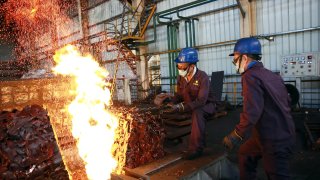
- In December, the Wall Street bank's commodities team closed out the bullish call it had held for much of 2020 on copper and other base metals and turned neutral on the sector.
- It cited an early peak and expected subsequent slowdown in Chinese credit, and a delayed spike in new sources of demand from global de-carbonization initiatives.
JPMorgan has defended its bearish call on base metals after what the bank called a "healthy amount of pushback" from investors.
In December, shortly after copper prices hit seven-year highs the Wall Street bank's commodities team closed out the bullish call it had held for much of 2020 on copper and other base metals and turned neutral on the sector. It cited an early peak and expected subsequent slowdown in Chinese credit, and a delayed spike in new sources of demand from global de-carbonization initiatives.
The bank now forecasts an average price of $7,700 per metric ton for spot copper in the first quarter of 2021, moving down toward a $6,500/mt average in the fourth quarter, with other base metals following a similar downward trajectory amid still persistent levels of oversupply.
In a note Monday, JPMorgan Head of Global Commodities Research Natasha Kaneva and her team highlighted that objections to the call had focused on credit cycles outside of China, "green" demand, supply underinvestment driving the next "supercycle" and continued copper stockpiling by China's State Reserve Bureau.
"Our long-held view is based on our assessment that the current China-driven supercycle has peaked and is unwinding as Chinese investment growth and exports as share of the country's GDP are set to decline," Kaneva reiterated.
A "supercycle" generally refers to a multi-decade period of above trend movement in base metal prices derived from a fundamental structural shift in demand. Until a new supercycle develops, prices will remain beholden to business cycles and driven by their more transient highs and lows, Monday's note concluded.
Money Report
Some of the contention from investors had been that a sectoral rather than a geographical shift in demand could mean a certain sector, such as green energy, gains enough share of global demand to drag prices out of business cycle pace and toward "supercycle highs."
"Our analysis estimates that a demand share of at least 20% of total is necessary to launch prices on the path towards supercyle highs," Kaneva responded.
"Policy guidance from China, the EU and the U.S. suggests that 'green' demand for copper likely will not cross this mark until the early 2030s."
Furthermore, she contended that supercycle highs are brought about by a persistent structural spike in demand that outstrips supply, but JPMorgan analysts estimate that around 1.7 million metric tons of additional copper will be mined in 2021-25, adjusted for disruptions, meaning supply will be ample.
"Supply additions are a result of large capital investments that were made in 2017-18, as producers approved projects on the back of the last price upswing in 2016-17. Expansion capex (capital expenditure) is projected to increase 150% over the next five years from its 2020 base," she said.
Chinese credit
A consistent criticism JPMorgan analysts received, according to the note, was that while the Chinese credit cycle may well have peaked, low interest rates and government stimulus will continue to support credit growth outside of China.
"Our analysis shows that while continued USD weakness and expanded, inflationary-hedging investor flow across commodities still remain major risks, when it comes to industrial metals prices, China's credit cycle matters much more than the Rest of the World," Kaneva said.
JPMorgan estimates that the Chinese State Reserve Bureau currently holds around 2.7 million metric tons copper stockpiles, almost three times as much as the most ever stockpiled by the U.S. However, this will not be enough to prop up prices, the bank argued.
"While impressive, in days of consumption, China 'only' has about 80 days' worth of inventories, while at the peak of the cold war, the U.S. amassed 308 days of consumption in copper stocks," Kaneva highlighted.
"While there is both motivation and precedent for the SRB to expand its holdings over the next 5-10 years, we believe it will be strategically timed during periods of price weakness."






